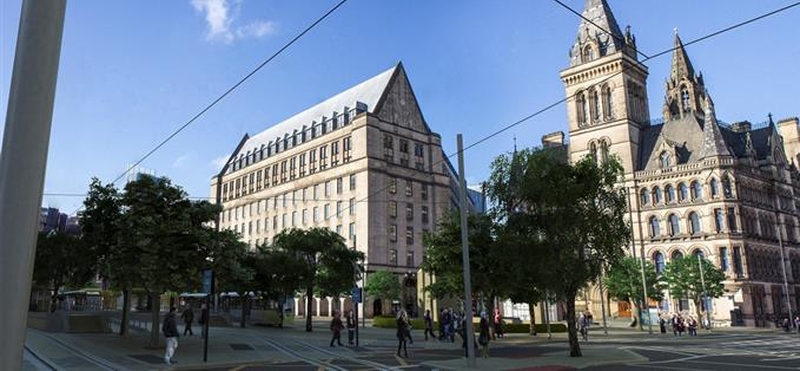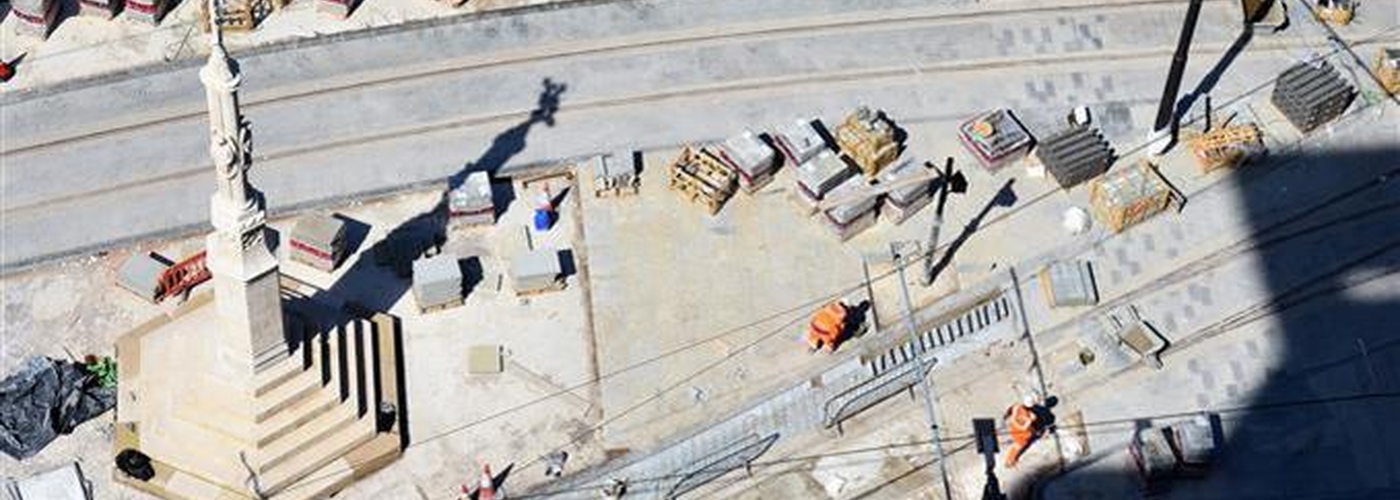Jonathan Schofield praises St Peter and digs for bones under a disappeared church
THE BISHOP of Manchester, David Walker, will officially rededicate St Peter’s Square cross this week. This marks the site of St Peter’s Church which stood on the site from 1788 to 1907. The church was demolished when the congregation had moved away and central Manchester, at the time, was becoming a central business district, losing its residential character.
The event is part of the completion works for what has become the benchmark square in Manchester. Designed by German landscape team Latz + Partner and decorated with high quality street furniture plus lovely purple flowering paulownias trees, the square is a triumph.
The controversial transfer of the cenotaph from the south west to the north west of the square has also been a success and resulted in a far more apt and reverential location for this solemn monument, which now faces the sober and distinguished rear of the Town Hall, rather than a newsagent.
The square would have been even better with fewer tramlines but it still shows up Piccadilly ‘Gardens’ for what it is; a cluttered mess. New plans for the ‘Gardens’ seem unlikely to result in anything nearly as sharp and disciplined as St Peter’s Square. The virtue of hard paving, clear sight lines and lots of seating is underlined in the new square as opposed to the irrational use of large lawns that are in need of endless repair.
The square is now a perfect foil for the Midland Hotel, Central Library, the Town Hall Extension, Manchester Art Gallery and the two new buildings on the east side, especially the marvellous One St Peter's Square by Glen Howell Architects.

St Peter's Cross was designed by busy architect and artist, Temple Moore, in 1908, in Portland Stone. This was an unfortunate choice of material. The stone being relatively soft means the sculptural detail on the south west side, where Manchester's prevailing winds come from, has been worn away and much of the decorative detail has been lost.
The site of the cross is interesting and important because of its associations.
On 16 August 1819, the first fatality at the Peterloo Massacre was a child by the name of William Fildes who was swept out of his mother’s arms as the Manchester and Salford Yeomanry charged past. The Yeomanry were on their way to break up a nearby meeting protesting at the lack of representation in Parliament and the lack of the vote for most of the population. There was only one MP locally and he was in the pocket of the Earl of Derby. This was not a species of democracy we would recognise.
Fourteen other people would die along with William Fildes on the day and many hundreds would be injured by the yeomanry and regular soldiers at Peterloo in one of the most notorious events of the 19th century in the UK.
The man leading the yeomanry was Hugh Hornby Birley. He was a mill owner with factories that still exist - reinvented as apartments – between Oxford Road and Cambridge Street. His church was St Peter’s.
Baby William was killed very close to the walls of the church, which was an upmarket ‘society’ place of worship. It had been designed by the nationally famous and prolific architect James Wyatt in the Classical style and was austere but handsome. It contained a painting by the Venetian Renaissance artist, Annibale Carraci, Descent from the Cross, which is now in St Ann’s Church.


Hugh Hornby Birley would be shunned by radicals and insulted in the street by his fellow Mancunians throughout his life for his role at Peterloo. He had a change of heart about representation for the city. From charging with drawn sword a crowd of unarmed citizens wanting the vote, a decade later he supported the campaign to grant two MPs to Manchester and one to Salford, which was achieved through the Great Reform Act of 1832.
Birley was buried in the family vault at St Peter’s Church in 1845 along with his wife Cicely, who had died two years earlier, and a three year old son Edward, who had died in 1839. The vault was a matter of metres from where Birley had launched his assault on the protesters in 1819 and where William Fildes had died. Birley is still there with his family, encased in a concrete raft under the current tramlines.
There is nothing to mark his grave, his victims fare better. Their names are illuminated red and set in Lancashire roses in the mosaic floor of the Library Walk entrance building between the Town Hall Extension and Central Library.
St Peter’s was demolished in 1907 after the congregation had moved away. It was given minor afterlife by glove manufacturer Richard Harding Watt who saved the columns of the church and incorporated them in his Elizabeth Gaskell Rooms in Knutsford. This is now the Belle Epoque restaurant and the columns and the cross in St Ann's Square can be seen as a reminder of events crucial to UK democracy 198 years ago.
St Peter's Square is wonderful example of how drab spaces can be re-invented. The rich history is a bonus.















